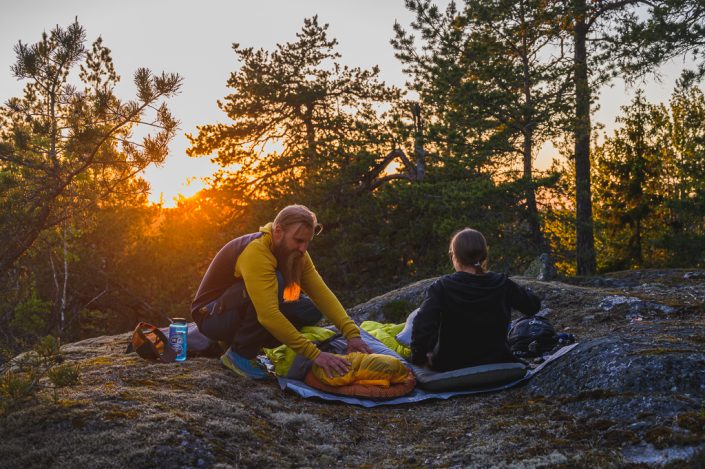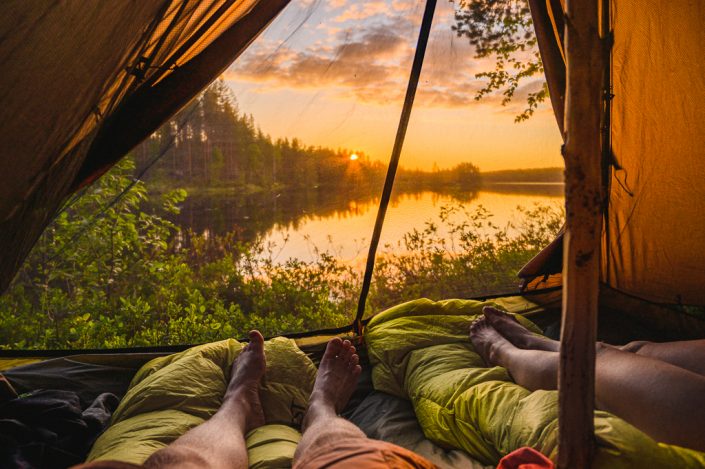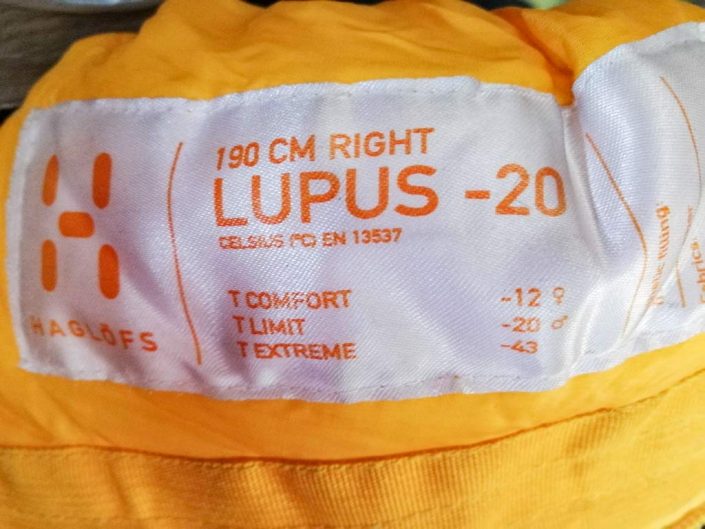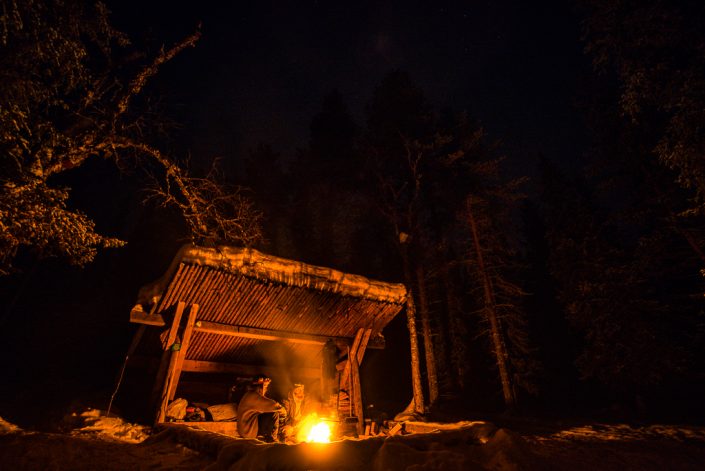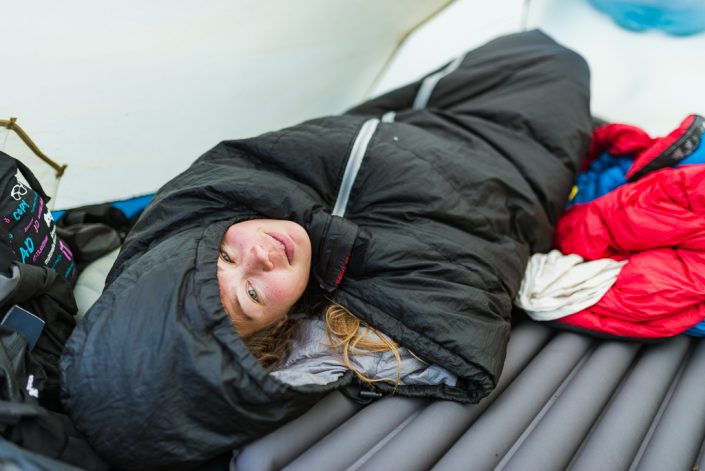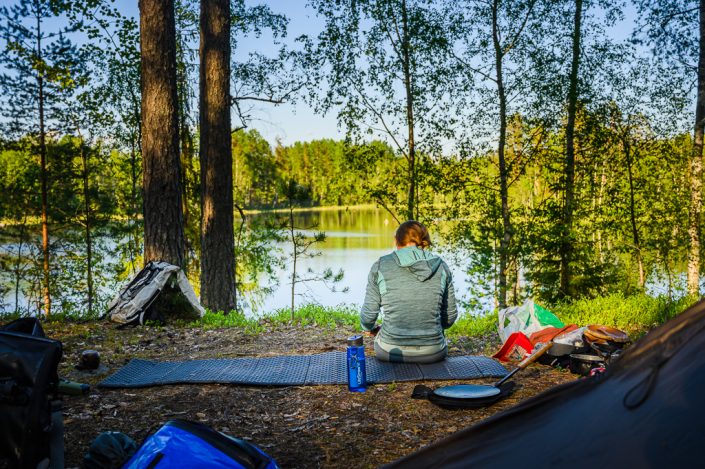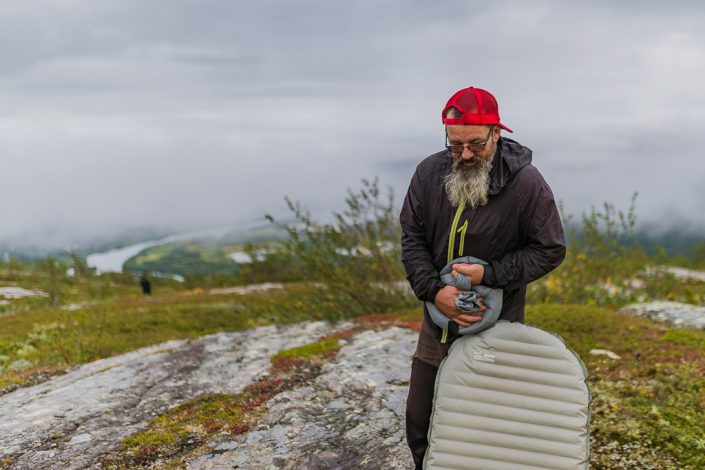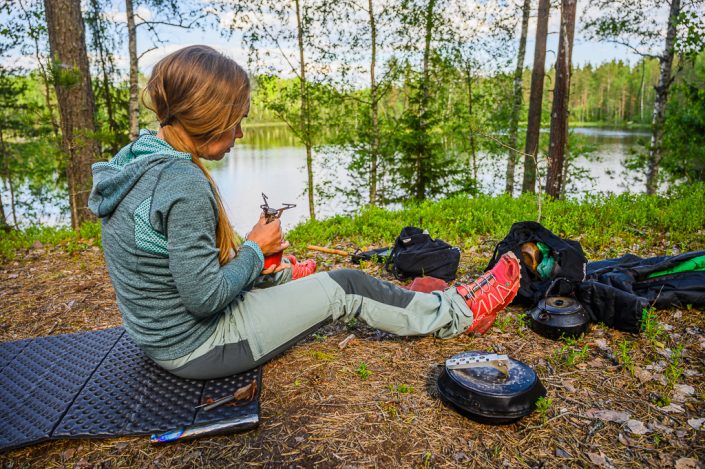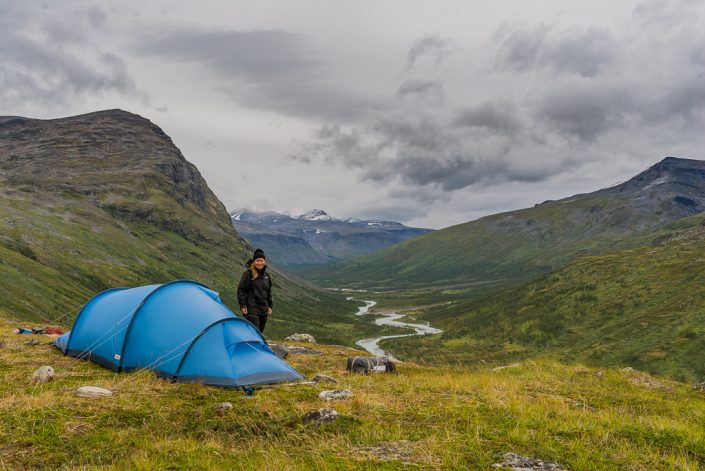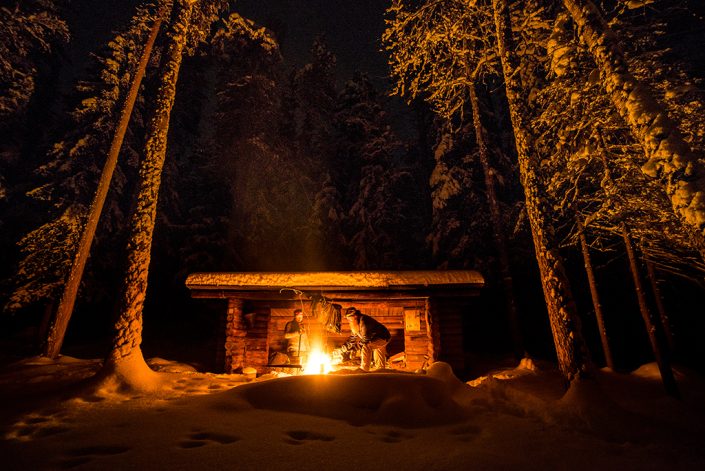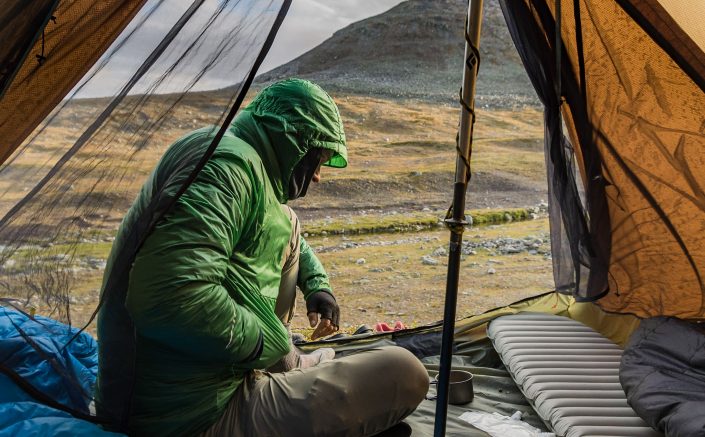

Choosing a sleeping bag and pad – how to pick a functional pair?
Choosing a suitable sleeping bag and pad is not the easiest task at the start of your hiking hobby. This guide will show you what options there are out there and what their differences are in practice.
 Mikko works as an outdoor specialist at our Turku Hansa shop. Mikko has almost 20 years of experience with helping hikers, and we’re certain that he is a familiar face to many of our customers. Mikko also acts as one of the outdoor experts for our Outdoor Guides.
Mikko works as an outdoor specialist at our Turku Hansa shop. Mikko has almost 20 years of experience with helping hikers, and we’re certain that he is a familiar face to many of our customers. Mikko also acts as one of the outdoor experts for our Outdoor Guides.
1. How to pick a good sleeping bag?
The first thing you should think of when choosing a sleeping bag is how it is going to be used. Will the sleeping bag be carried on long hikes or will it largely be used while camping next to your vehicle, or perhaps close to your cabin? In what weather and what climate will the bag be slept in? What is your budget?
If the sleeping bag is not going to be carried over long distances, its weight and packed size won’t matter much. In this case you will only have to make sure that the sleeping bag is warm enough for its intended use.
However if the sleeping bag is going to be used while hiking, and you plan on carrying all your gear in the backpack, you should pay more attention to the weight and size of the sleeping bag. You should always choose a slightly warmer bag than the climate you intend to use it in, within reason of course. A winter sleeping bag is way too warm for comfort in the summer, and will also make you carry around unnecessary weight.
So a good sleeping bag is one that keeps you warm but isn’t too heavy. A summer hike in Lapland might require a sleeping bag that will still keep you comfortably warm in near freezing temperatures. That kind of a sleeping bag is versatile and will remain comfortable from spring to fall. However it is usually not warm enough to sleep in during the winter season.
The comfort temperature of a sleeping bag
The idea behind the sleeping bag is to act as an insulating layer between you and the elements. Your body produces heat, and the sleeping bag acts as a barrier between the warmer inside and the colder outside air.
There are so called three season sleeping bags out there, as well as summer sleeping bags and a plethora of other confusing terms, but the easiest way to approach this is to think of the conditions you are going to be using the sleeping bag in and compare them to the so-called comfort rating.
Roughly put, the comfort rating signifies a temperature in which you can still sleep comfortably in your sleeping bag. In our online store, we report the comfort ratings differently for men and women, while manufacturers often refer to Comfort and Limit ratings. In that case the Comfort rating refers to comfortable usage temperature for women, and the Limit rating refers to the comfortable usage temperature for men. Extreme rating signifies temperatures in which you can still use the sleeping bag without succumbing to hypothermia.
You can compare the ratings between different manufacturers, but there are other factors that can affect your comfort, and different people experience cold temperatures in different ways. The only way you can figure out your comfort zone is by testing sleeping bags and trying different things.
Staying warm is not just about your cold tolerance and the type of your sleeping bag. There are other factors at play, such as your sleeping pad, your clothing, your hunger levels, how cold it was when you went to bed, and where you are spending the night (under the sky, in an open lean-to, or in a tent, protected from the wind).
What’s the difference between sleeping bag synthetic and down filling?
Sleeping bag filling is either synthetic, down, or a mixture of both. If we compare synthetic and down sleeping bags that have the same comfort rating they will naturally be equally warm, but the down bag will be smaller and lighter than its synthetic counterpart. This is due to the fact that down is a more efficient insulator than synthetic fibers.
Synthetic fibers are usually more resistant to moisture, although nowadays it is easy to find plenty of specially treated down filling that can also withstand moisture. If the sleeping bag gets wet the synthetic filling is considerably faster to dry.
Down also compresses much better, so you are able to pack the sleeping bag in a very small space.
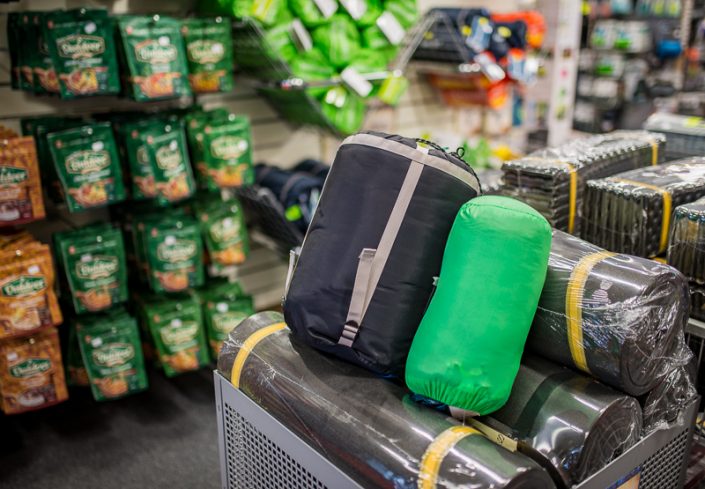 A picture of sleeping bags with a down and a synthetic filling with the same Comfort rating. The sleeping bag with a down filling can be further compressed into an even smaller space.
A picture of sleeping bags with a down and a synthetic filling with the same Comfort rating. The sleeping bag with a down filling can be further compressed into an even smaller space.
If you want a light sleeping bag that packs into as small a space as possible, then a down sleeping bag is the best choice. But if weight and size aren’t too important then sleeping bags with synthetic filling are a better choice, since they are cheaper.
There are different qualities of down on the market, its quality is measured with the FP value (Fill Power). The greater the FP value, the higher the quality of down and the better its insulating properties are. This means a smaller and lighter sleeping bag at similar Comfort Ratings. FP600 is on the lower end, and FP900 is on the higher end of the quality scale.
All of the Scandinavian Outdoor down products are sourced from ethically certified production facilities.
 Another option to consider as an alternative to the sleeping bag is a quilt. A Quilt is a more stripped down version of the sleeping bag. In the sleeping bag, the padding flattens underneath the sleeper and loses a lot of its insulating properties. The lower part of the quilt has been purposefully left without filling, making the quilt a good choice when you want to save weight. The quilt is usually attached to a sleeping pad and is thus held in place when you turn inside of it.
Another option to consider as an alternative to the sleeping bag is a quilt. A Quilt is a more stripped down version of the sleeping bag. In the sleeping bag, the padding flattens underneath the sleeper and loses a lot of its insulating properties. The lower part of the quilt has been purposefully left without filling, making the quilt a good choice when you want to save weight. The quilt is usually attached to a sleeping pad and is thus held in place when you turn inside of it.
Tips for using a sleeping bag
It’s a good idea to test your sleeping bag in less challenging conditions first to find out how well it can handle the weather before embarking on a proper hike. By purchasing a liner for your sleeping bag, you will keep the sleeping bag clean for longer as well as gain extra warmth. At bedtime, you should leave the sleeping pad, especially a down filled one, to puff up for a while, and then ventilate the sleeping bag properly in the morning when you wake up before stowing it away. Some hikers don’t actually use packing bags, but stow their sleeping bag directly in a backpack instead. However, it is always a good idea to protect your sleeping bag from the rain so that it does not get wet while in the backpack.
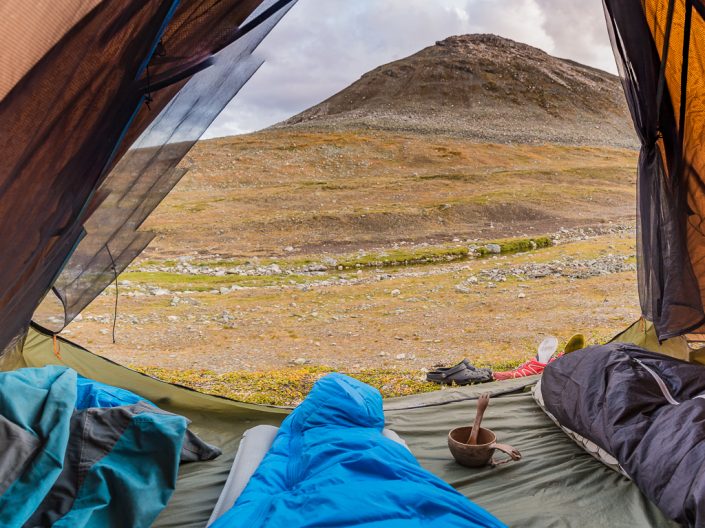 If you are planning on hiking in Lapland during the summer you should choose a sleeping bag and pad that are suitable even for freezing temperatures. That way you are sure to stay warm even if the weather turns cold.
If you are planning on hiking in Lapland during the summer you should choose a sleeping bag and pad that are suitable even for freezing temperatures. That way you are sure to stay warm even if the weather turns cold.
You should think of the whole picture if you camp and hike year round. If that is the case, a single sleeping bag won’t suffice, because you will need a winter sleeping bag during the cold season and that is, in turn, too warm to use in the summer. You should consider getting two or even three different sleeping bags instead. One option would be to use a sleeping bag that is rated for barely freezing temperatures during the summer season, and then use a sleeping bag comfortable down to -10c during the spring and autumn seasons. That way you could use them nested inside each other during the winter.
2. How to pick a good sleeping pad?
In addition to the sleeping bag, the biggest contributing factor to staying warm is the sleeping pad. When you sleep in a sleeping bag, it compresses under you and loses most of its insulating ability. The insulation of the sleeping bag is provided by the air that is situated between the down or the synthetic fibers. The insulation needed under the sleeper is therefore mainly provided by the sleeping pad, a warm sleeping bag alone is not sufficient.
A sleeping bag that is too cold can be compensated for in many ways, while a poorly insulating sleeping pad is more difficult to replace. That means you should pay careful attention to the insulating properties of the pad, measured by the R value, when you purchase it. The higher the R value, the better are the insulating properties of the pad.
One can generally say that sleeping pads with R values below 3 are meant to be used in the summer, three season pads should rate higher than 3, and a winter sleeping pad might need to have an R rating of 5 or higher.
What is the difference between a closed-cell foam and a self-inflating sleeping pad?
Sleeping pads mostly come in two varieties, closed-cell foam, and self-inflatable. Close-cell foam pads are usually cheaper, they handle being scrunched up better, and usually don’t mind moisture or even sparks flying from the camp fire very much. A closed-cell pad can also be used as a handy seating pad when having a break or when spending the evening sitting by the fire.
Closed-cell foam pads are very light, but are rather large. Many backpacks do however have handy attachment points for closed-cell foam pads that allow them to be carried strapped to the outside of the backpack. Closed-cell foam pads often have R ratings below 4, so they are not the warmest of choices.
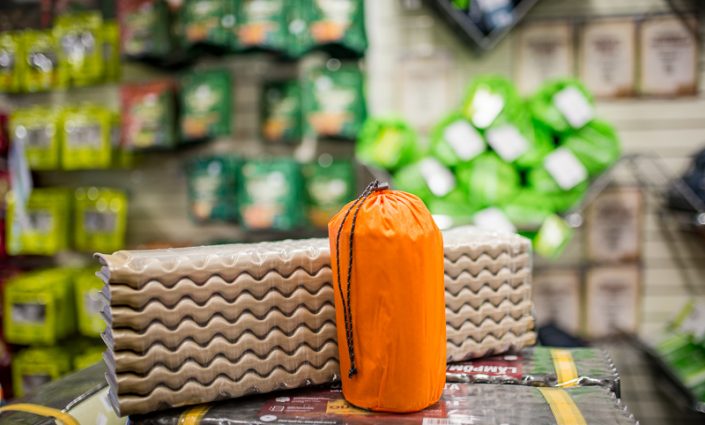 A size comparison of a closed-cell foam pad and an inflatable pad. The inflatable pad wins this round.
A size comparison of a closed-cell foam pad and an inflatable pad. The inflatable pad wins this round.
Inflatable sleeping pads can be packed into a smaller space. Inflatable pads, especially the thicker models, are softer to sleep on, but are more damage prone than their closed-cell foam counterparts. A punctured sleeping pad is not difficult to repair, repair kits are often included along with the packing bag. Finding the puncture, however, can sometimes be difficult.
There is a wide variety of inflatable sleeping pads, with R values ranging from 1 to 9. Inflatable sleeping pads can be separated into two main varieties. First there is the so called self-inflating kind, where you just have to open a valve for the pad to start to slowly fill with air, and then complete the inflation process by blowing it up further with your mouth. Self-inflating pads are usually 1 to 4 cm thick. Then there is the inflatable air pad that is inflated with a built in or separate pump, or with a special bag, making inflation a quick and easy process. Pads like this can be up to 9 cm thick, winter models often also have down or synthetic fiber insulation in addition to the air, thus achieving an R rating as high as 9.
So if you want a sleeping pad that can be packed into as small a space as possible, choose an inflatable pad. And if size is not an issue, you should go with the cheaper closed-cell foam option. The warmest option for winter use is an inflatable pad. You can also use two sleeping pads on top of one another during the winter months. A good addition to an inflatable sleeping pad is a cell foam pad with a reflecting foil surface that can be placed against your body to reflect its heat back unto itself.
Tips for choosing a sleeping pad
A high-quality inflatable sleeping pad is usually the most comfortable choice for most people. In addition to that you can also carry along a closed-cell foam pad that can be shortened to reduce weight.Then you can use the foam pad as a sitting pad and as an extra insulation layer to go under the inflatable pad.When you carry two sleeping pads you can use the lighter and smaller kind of inflatable pad, thus saving both weight and space.
If you sleep outdoors the whole year round, it is a good idea to purchase a well insulating pad straight away. Some of the inflatable sleeping pads have a high R rating and can be packed into a small space. A pad like that can be used throughout the year, with an extra layer of insulation provided by a closed-cell foam pad if necessary.
How to ensure warm nights during a hike?
During a hike, you have to make do with the gear you bring along with you. If cold weather manages to sneak up on you and you suspect that your sleeping bag and pad might not be up to the task of providing you with a warm place to sleep, there are a few tricks you can use to improve the situation.
First of all you shouldn’t go to sleep when you’re already cold. Try to warm yourself up by doing an exercise routine, or warm up before fire before crawling into your sleeping bag. A sleeping bag liner will provide you with a bit of extra warmth, and a pillow will grant you some comfort A pillow can also be made out of a drybag or something similar stuffed with some clothing.
Many prefer to sleep wearing a warm and dry merino wool base layer, you should also change into dry socks before going to sleep. In addition to this, you can also put on some more clothes. Airy clothing, such as down jackets, fleeces, or woolen clothing work the best. Do make sure, however, that you are not packing yourself into the sleeping bag too tightly.
You should eat a proper meal and take care of your hydration before going to sleep. If you have a water bottle that can stand boiling water and has a good cap (for example Nalgene), you can use it as a warm water bottle inside your sleeping bag.
Toes are usually the first body part to get cold, so wear warm and dry socks. Some people also lose heat from their hip area, so a padded skirt or a down jacket wrapped around your hips will help keep you warm.
As a final tip, if you have to pee, take care of it immediately! Otherwise you will just lose sleep needlessly, as you will have to venture out of your sleeping bag sooner or later in any case.
Sleeping bags and pads for all season use
If you sleep outdoors during all seasons, you won’t make do with just one sleeping bag. A good winter sleeping bag is so heavy that it makes no sense to carry it around during the summer, and it is too hot for comfort as well.
When hiking becomes a year-round hobby, you should think of the bigger picture when purchasing a sleeping bag and pad, so that they can serve you best in all conditions.
If you like hiking in Lapland during the summer, you should still choose a sleeping bag in which you can sleep in temperatures close to zero degrees celsius. There are plenty of lightweight down bags suitable for this that are still comfortable to carry. During southern winters, a sleeping bag comfortable to about -10c often does the job, but during winter hikes in Lapland, even a sleeping bag that is rated to -20c may not be enough. So you already need three separate sleeping bags, OR you can combine the summer sleeping bag and the sleeping bags suitable for use in the southern winter conditions. In that case, you should make sure that the winter sleeping bag is large enough to accomodate another sleeping bag inside it with some room to spare.
There are some fairly light sleeping pads out there that have a good R-value, and these can be used all year round. However, it’s worth considering whether it would be good to have a lighter pad for use in the summer and a slightly heavier one for winter hikes. You can also bring an additional foam pad along on winter hikes to use with the inflatable pad. It can be used as a seating pad besides providing additional insulation and protection for the inflatable pad.
Read more:
Posted: 12.8.2020Modified: 16.1.2025
